 April What'sNEW Jan - Mar 2024 April What'sNEW Jan - Mar 2024
During DNA replication, parental nucleosomes bearing epigenetic marks are disassembled ahead of each replication fork to enable duplex DNA unwinding and subsequent DNA synthesis. To maintain the fidelity of the epigenetic landscape, the evicted parental histones are subsequently recycled to newly synthesized strands by well-recognized yet poorly understood replication-coupled mechanisms.
Epigenitic inheritance is an ongoing surprise for the theory of evolution. New characteristics may acqired and passed down with no change in the sequence of chromosomal DNA. Instead, the signals that control its expression can become altered and then vertically inherited along with it. How this happens is a new field of research. A Chinese team has made remarkable progress using cryo-electron microscopy on yeast cells. They see an intricate and complex system that disassembles and reassembles histones. The details witnessed so far are astounding.
 "Parental histone transfer caught at the replication fork," by Ningning Li, Yuan Gao, Yujie Zhang, Daqi Yu et al., doi:10.1038/s41586-024-07152-2, Nature, 28 Mar 2024. "Parental histone transfer caught at the replication fork," by Ningning Li, Yuan Gao, Yujie Zhang, Daqi Yu et al., doi:10.1038/s41586-024-07152-2, Nature, 28 Mar 2024.
A still-honored dictum is, Nothing in biology makes sense except in the light of evolution (Theodosius G. Dobzhansky, 1964). But the words evolution and evolve are found nowhere in the text of the report in Nature. How the epigenetic system illustrated above might have evolved, as that word is usually understood, is difficult to imagine. Examples of the same difficulty are countless. We need a new paradigm.
 Robust Software Management discusses and lists many more, similarly difficult examples. Robust Software Management discusses and lists many more, similarly difficult examples.
 "How did the Big Bang get its name? Here's the real story," by Helge Kragh, Nature, 25 Mar 2024. "How did the Big Bang get its name? Here's the real story," by Helge Kragh, Nature, 25 Mar 2024.
 The End and the Big Bang discusses alternatives. The End and the Big Bang discusses alternatives.
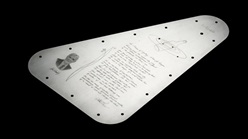
 "Inscribing Our Journey to Europa," by Paul Gilster, Centauri Dreams, 13 Mar 2024. "Inscribing Our Journey to Europa," by Paul Gilster, Centauri Dreams, 13 Mar 2024.
 "NASA Unveils Design for Message Heading to Jupiter's Moon Europa," by Gretchen McCartney, NASA +PhysOrg, 08 Mar 2024. "NASA Unveils Design for Message Heading to Jupiter's Moon Europa," by Gretchen McCartney, NASA +PhysOrg, 08 Mar 2024.
 What Difference Does It Make? includes thoughts about messages from Earth. What Difference Does It Make? includes thoughts about messages from Earth.
Origin-of-Life research gets a synopsis and recommendations from two of its veterans, Nick Lane and Joana C. Xavier. These evolutionary biochemists in the UK discuss "prebiotic soup," and "hydrothermal systems," which they deem the major approaches to the subject. Both approaches have separate problems, and neither can string together a compelling story. Nor can any other approach, but no one is giving up. The thesis of the review is captured in these sentences:
An important feature of these competing frameworks is that they must ultimately converge on cells with genes and proteins — on life as we know it on Earth. This convergence offers new possibilities for collaboration, because any answer will probably feature aspects of more than one framework. Exactly where these convergences occur will depend on which hypothetical steps are disproved.
How to disprove an hypothesis is not obvious, because a workaround can always be dreamed up. (Otherwise, Pasteur would have settled the matter by 1864.) This new, seemingly fair and comprehensive review acknowledges huge gaps in all scenarios, with hardly a mention the hardest part of the problem, the software. Of course, the possibility of life with no "origin" never enters the picture. I am again reminded of medieval alchemy, which preoccupied Isaac Newton until he died. Transforming lead into gold was not "disproved," it just never succeeded. Meanwhile, early modern chemistry asked entirely different questions. As chemistry became more and more fruitful, alchemy quietly vanished.

 "To unravel the origin of life, treat findings as pieces of a bigger puzzle," by Nick Lane and Joana C. Xavier, Nature, 27 Feb 2024. "To unravel the origin of life, treat findings as pieces of a bigger puzzle," by Nick Lane and Joana C. Xavier, Nature, 27 Feb 2024.
 The RNA World: and Other Origin-of-Life Theories: has comprehensive updates. The RNA World: and Other Origin-of-Life Theories: has comprehensive updates.
| 04 Mar 2024 |
What'sNEW about HGT


|
...we hypothesize that EVs [extracellular vessicles] are a main driver of HGT in the ocean.
A team from the Max-Planck Institute for Marine Microbiology says this after analyzing ocean particles smaller than bacteria that contain genetic material. They call the studied particles "protected environmental DNA," or peDNA. Comparing EV DNA sequences with that of viruses and GTAs, they conclude that a surprisingly large fraction of peDNA is found in EVs. It's another route for microbial HGT traffic.

 "Extracellular vesicles are the main contributor to the non-viral protected extracellular sequence space," by Dominik Lücking et al., doi:10.1038/s43705-023-00317-6, ISME Communications, 17 October 2023. "Extracellular vesicles are the main contributor to the non-viral protected extracellular sequence space," by Dominik Lücking et al., doi:10.1038/s43705-023-00317-6, ISME Communications, 17 October 2023.
 Thanks, Trends in Genetics. Thanks, Trends in Genetics.
 New genes can be acquired only via HGT: the local hub for HGT among prokaryotes since 10 Mar 2021. New genes can be acquired only via HGT: the local hub for HGT among prokaryotes since 10 Mar 2021.
 "Astronomers reveal a new link between water and planet formation," University of Manchester via PhysOrg, 29 Feb 2024; re: "Astronomers reveal a new link between water and planet formation," University of Manchester via PhysOrg, 29 Feb 2024; re:
 "Resolved ALMA observations of water in the inner astronomical units of the HL Tau disk," S. Facchini, L. Testi, E. Humphreys et al., doi:10.1038/s41550-024-02207-w, Nat Astron, 29 Feb 2024. "Resolved ALMA observations of water in the inner astronomical units of the HL Tau disk," S. Facchini, L. Testi, E. Humphreys et al., doi:10.1038/s41550-024-02207-w, Nat Astron, 29 Feb 2024.
| 29 Feb 2024 |
What'sNEW about HGT


|
...STING proteins... and their bacterial homologues showcase the evolutionary trajectory of immune signaling from bacteria to animals through horizontal gene transfer.
 "Conservation and similarity of bacterial and eukaryotic innate immunity," by Hannah E. Ledvina and Aaron T. Whiteley, Nature Reviews Microbiology [abstract], 28 Feb 2024. "Conservation and similarity of bacterial and eukaryotic innate immunity," by Hannah E. Ledvina and Aaron T. Whiteley, Nature Reviews Microbiology [abstract], 28 Feb 2024.
 Commentary by Anthony Raphael, Medriva [link], 28 Feb 2024. Commentary by Anthony Raphael, Medriva [link], 28 Feb 2024.
 Viruses and Other Gene Transfer Mechanisms has background and related links. Viruses and Other Gene Transfer Mechanisms has background and related links.
 Thanks, Google Alerts. Thanks, Google Alerts.
Life on Mars gets full attention in a 2-hour dramatic documentary from filmmaker Brian Dobbs. Man-on-the-street flash comments (see trailer, right) cede the stage to Chandra Wickramasinghe, the late Gil Levin and predominantly, Richard Hoover. They give the Viking LR experiments (1976) and the crinoid-like image seen by the Opportunity rover (2004) careful, needed exposure.
The underlying theme is that Mars was once an ocean-bearing, living planet like Earth. This is further explored with other scientists who speculate about a past civilization and the loss of Mars' biosphere. Geological features such as unusual craters, pyramid-shaped mountains and Valles Marineris provide much of that evidence. Pareidolia is mentioned.
The video has a lively, Sci-Fi vibe, with both solid evidence and controversial questions.
 Blue Planet Red, "...history, evidence for life, and catastrophes that contributed to the death of Mars," $6.99 on Vimeo, by Brian Cory Dobbs, 2023. Blue Planet Red, "...history, evidence for life, and catastrophes that contributed to the death of Mars," $6.99 on Vimeo, by Brian Cory Dobbs, 2023.
 Life on Mars! has background. Life on Mars! has background.
| 19 Feb 2024 |
What'sNEW about HGT


|
 "Eukaryotic CD-NTase, STING, and viperin proteins evolved via domain shuffling, horizontal transfer, and ancient inheritance from prokaryotes," by Edward M. Culbertson and Tera C. Levin, PLoS Biol., 08 Dec 2023. "Eukaryotic CD-NTase, STING, and viperin proteins evolved via domain shuffling, horizontal transfer, and ancient inheritance from prokaryotes," by Edward M. Culbertson and Tera C. Levin, PLoS Biol., 08 Dec 2023.
 "Tracing the evolutionary origins of antiviral immunity," by James B. Eaglesham and Philip J. Kranzusch, PLoS Biol., 06 Feb 2024.
In this example, life evolves by using programming that is already available, as expected in cosmic ancestry. "Tracing the evolutionary origins of antiviral immunity," by James B. Eaglesham and Philip J. Kranzusch, PLoS Biol., 06 Feb 2024.
In this example, life evolves by using programming that is already available, as expected in cosmic ancestry.
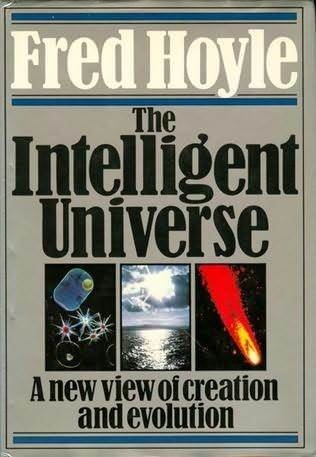 Fred Hoyle never expected biology to occupy his attention, but after Chandra Wickramasinghe showed him that interstellar dust looks like freeze-dried bacteria, he looked closely. While investigating the subject with Chandra, in 1983, he published The Intelligent Universe: A New View of Creation and Evolution. Now I am re-reading it.
Fred Hoyle never expected biology to occupy his attention, but after Chandra Wickramasinghe showed him that interstellar dust looks like freeze-dried bacteria, he looked closely. While investigating the subject with Chandra, in 1983, he published The Intelligent Universe: A New View of Creation and Evolution. Now I am re-reading it.
As a schoolboy, Hoyle was already skeptical about the darwinian theory of evolution. Quick as lightning, he saw the connection between panspermia and the evolution of life. He saw that viruses could introduce new genes, that silent DNA might contain useful genetic programming, and that cosmic life could supply what random mutations can't. In the intervening forty years, astronomy, genetics and Earth sciences have advanced considerably, but Hoyle's initial skepticism about evolution and the origin of life has only been reinforced.
The first five chapters of this book make a strong case for cosmic ancestry, as I call it. From there, Hoyle's restless mind takes him even further, coming next to SETI and then the big bang vs. steady state cosmology (where Hoyle frankly admits some of his own wrong turns.) He blames darwinian nihilistic philosophy for much of the twentieth century's trouble. He wonders about quantum theory and free will, life in other media, the evolution of physical law, the religious tendency and a lot more.
Fred Hoyle was a master of many subjects, as well as a best-selling writer, so the text is instructive and a delight to read. The illustrations are superb. The book is no longer in print, but used copies are readily available.
 The Intelligent Universe by Fred Hoyle, Michael Joseph Limited, London
1983. The Intelligent Universe by Fred Hoyle, Michael Joseph Limited, London
1983.
 "...The Intelligent Universe: A summary & review" [link], by Gert Korthof, updated 2006. "...The Intelligent Universe: A summary & review" [link], by Gert Korthof, updated 2006.
 Hoyle and Wickramasinghe's Analysis of Interstellar Dust has background. Hoyle and Wickramasinghe's Analysis of Interstellar Dust has background.
 An Interview with Fred Hoyle, 1996. An Interview with Fred Hoyle, 1996.
| 15 Feb 2024 |
What'sNEW about HGT


|
Our study ...suggests that retroviral endogenization played a prominent role in the emergence of vertebrate myelin.
 "A retroviral link to vertebrate myelination through retrotransposon-RNA-mediated control of myelin gene expression," by Tanay Ghosh et al., Cell, 15 Feb 2024. "A retroviral link to vertebrate myelination through retrotransposon-RNA-mediated control of myelin gene expression," by Tanay Ghosh et al., Cell, 15 Feb 2024.
 "Ancient retroviruses played a key role in the evolution of vertebrate brains...," PhysOrg, 15 Feb 2024. "Ancient retroviruses played a key role in the evolution of vertebrate brains...," PhysOrg, 15 Feb 2024.
 Viruses and Other Gene Transfer Mechanisms has links to many more examples of HGT. Viruses and Other Gene Transfer Mechanisms has links to many more examples of HGT.
 Thanks, Kevin Keogh, for a link to commentary on Neuroscience News.com, 15 Feb 2024. Thanks, Kevin Keogh, for a link to commentary on Neuroscience News.com, 15 Feb 2024.
Cosmic Dust Could Spread Life from World to World Across the Galaxy, according to commentary on a new article by Z.N. Osmanov of the Free University of Tbilisi. The idea has been around for at least a century; Swedish scientist Svante Arrhenius described it in Worlds in the Making (English translation 1908). Of course Fred Hoyle and Chandra Wickramasinghe (H&W) have championed the theory since the 1970s. Now Osmanov, in a brief paper, calculates that dust with at least remnants of life could have reached 3x10^7 planets in the Milky Way. Cells travelling far would suffer radiation damage, but plenty of complex organics would survive, he says.
 "The possibility of panspermia in the deep cosmos by means of the planetary dust grains," by Z.N. Osmanov, arXiv:2402.04990, 07 Feb 2024. "The possibility of panspermia in the deep cosmos by means of the planetary dust grains," by Z.N. Osmanov, arXiv:2402.04990, 07 Feb 2024.
 "Cosmic Dust Could Spread Life...," by Evan Gough, Universe Today, 13 Feb 2024. "Cosmic Dust Could Spread Life...," by Evan Gough, Universe Today, 13 Feb 2024.
 Thanks, Google Alerts. Thanks, Google Alerts.
In cosmic ancestry whole cells must deliver life. Naked cells spread by radio-panspermia would need protection from radiation damage, but a coating of organics would allow some to survive. For protection from cosmic rays over long times, several feet of rock or ice would be needed. Comets, not considered in the new study can provide this.
 Introduction... features H&W, mentions Arrhenius, and has history and links to others. Introduction... features H&W, mentions Arrhenius, and has history and links to others.
 Panspermia Asks New Questions lists various kinds of panspermia. Panspermia Asks New Questions lists various kinds of panspermia.
 Hoyle and Wickramasinghe's Analysis of Interstellar Dust makes the case for bacteria in interstellar space. Hoyle and Wickramasinghe's Analysis of Interstellar Dust makes the case for bacteria in interstellar space.
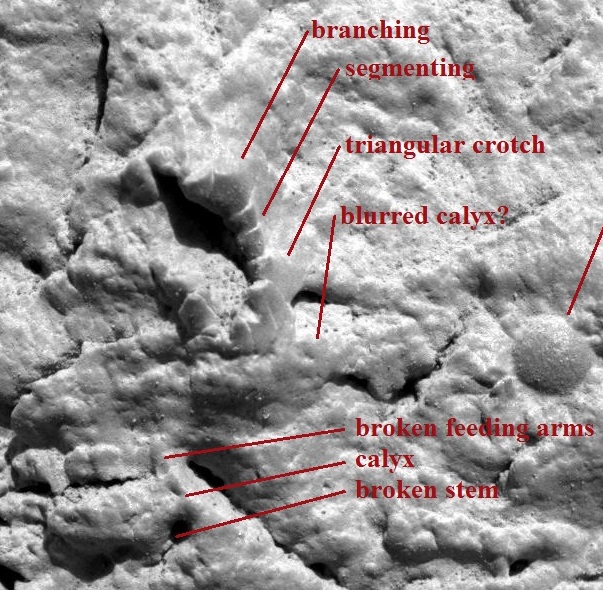 To see what is in front of one's nose needs a constant struggle
To see what is in front of one's nose needs a constant struggle
— George Orwell, 1946.
In 2004, the Opportunity rover on Mars photographed tiny fossils that look biological. The shapes have features that closely match those of crinoids, sea animals related to starfish and sea urchins. The features include branching, segmenting, a flat-faced triangular crotch and a calyx-and-stem, all properly arranged and appropriate in size (see annotated image, right, cropped FoV c. 2x2 cm | uncropped image). I have occasionally shown these to NASA-affiliated scientists. Without exception, they have only glanced, or not, and dismissed the subject.
 28 Oct 2015: our notice including the Earthly crinoid fossils for comparison. Look for the listed features in them. 28 Oct 2015: our notice including the Earthly crinoid fossils for comparison. Look for the listed features in them.
 Thanks for alerting me to the fossil, Richard Hoover. Thanks for alerting me to the fossil, Richard Hoover.
Last week, I contacted a distinguished former member of the Opportunity science team. He kindly replied with discussion of Viking and Opportunity, but his summary comment was, "...many structures interpreted as crinoid calices ...are actually small hematitic nodules formed during an episode of fluid flow through the sediment...." I wasn't sure he had looked at the right image, so I sent him a link to it. He replied, "The upper bit that looks like three structures in alignment could be interlocking hematite concretions; such things are observed regularly in Eagle crater images." Still not sure, I asked for a picture of the concretions he had in mind. He replied with this image that includes conjoined blueberries, taken in Eagle Crater on Sol 46 (next below, FoV 3x3 cm | larger image). He suggested we agree to disagree.
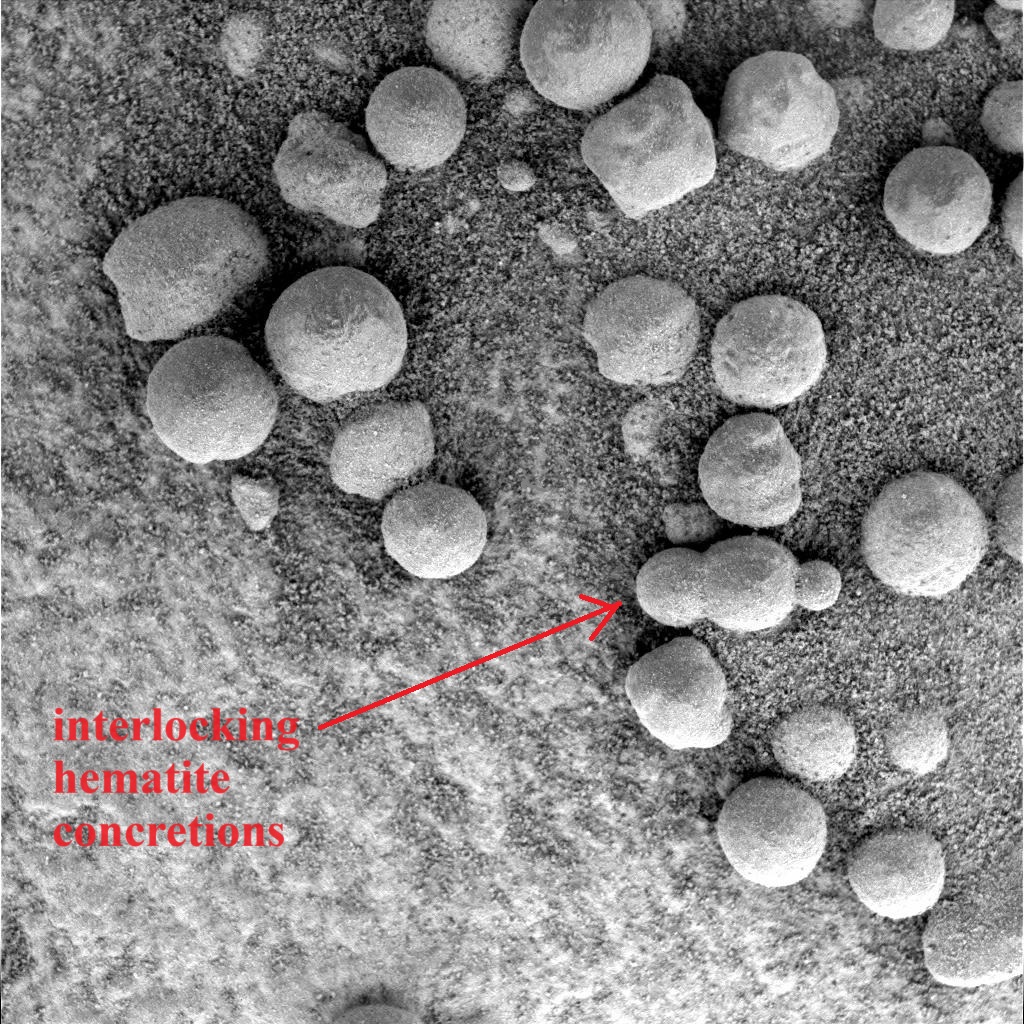
NASA's reluctance to look at its own image of the fossil seen on Sol 34 suggests hidden politics and/or willful blindness. Perhaps actually finding extraterrestrial life would give NASA political headaches it doesn't currently have. It seems NASA prefers to proceed very slowly, and to treat all evidence of extraterrestrial life dismissively. The situation is frustrating.
 Life on Mars! has history and updates. Life on Mars! has history and updates.
 09 Jan: This book review includes background. 09 Jan: This book review includes background.
PS: NASA used the RAT to destroy the above fossils within three hours, but commanded Opportunity to observe the "interlocking concretions" for three days (Sols 46-48).
| 26 Jan 2024 |
What'sNEW about HGT


|
...a class of diverse RNAs that have colonised, and gone unnoticed in, human, and global microbiomes.
A multi-disciplinary international team that has found and studied unfamiliar circles of RNA in microbes of human mouth and gut. With ∼1,000 nucleotides and an open reading frame, they code for proteins of unknown function. They have been named "Obelisks," because they form a rod-like secondary structure. Their affects on human health are not known.

 "Viroid-like colonists of human microbiomes," by Ivan N. Zheludev et al., BioRxiv, 21 Jan 2024. "Viroid-like colonists of human microbiomes," by Ivan N. Zheludev et al., BioRxiv, 21 Jan 2024.
 Thanks for an alert, Kevin Keogh. Thanks for an alert, Kevin Keogh.
In cosmic ancestry, evolution depends on genetic programming that is already available and software management systems that can navigate through it. If so, the discovery of functional sequences unanticipated by darwinian logic can be expected.
 Viruses and Other Gene Transfer Mechanisms has more about better-known viral elements. Viruses and Other Gene Transfer Mechanisms has more about better-known viral elements.
If life evolves by cosmic ancestry, it must use genetic programming that is already available. This would require genes to exist before they are needed, and "new" genes to be acquired by HGT. Indeed, these surprises are now well observed. Moreover, the range of possible evolutionary outcomes will be much narrower than the mainstream theory would allow. As Jerry Fodor and Massimo Piattelli-Palmarini say in What Darwin Got Wrong, Extant and extinct life forms are a very tiny subset of what is possible in the abstract.
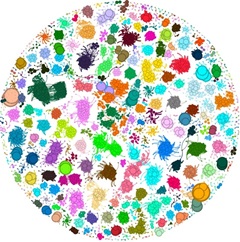 Evidence for deterministic evolution now comes from a computer analysis of several thousand complete E. coli genomes by an interdisciplinary trio at The University of Nottingham. ...our results lead us to suggest that it is likely that rewinding the tape back to the start of E. coli evolution would still result in hundreds or thousands of predictable events taking place that are not contingent on those highly unlikely events unique to each replaying of the tape.
Evidence for deterministic evolution now comes from a computer analysis of several thousand complete E. coli genomes by an interdisciplinary trio at The University of Nottingham. ...our results lead us to suggest that it is likely that rewinding the tape back to the start of E. coli evolution would still result in hundreds or thousands of predictable events taking place that are not contingent on those highly unlikely events unique to each replaying of the tape.
 "Contingency, repeatability, and predictability in the evolution of a prokaryotic pangenome," by Alan J. S. Beavan, Maria Rosa Domingo-Sananes and James O. McInerney, PNAS, 26 Dec 2023 (includes illustration, right). "Contingency, repeatability, and predictability in the evolution of a prokaryotic pangenome," by Alan J. S. Beavan, Maria Rosa Domingo-Sananes and James O. McInerney, PNAS, 26 Dec 2023 (includes illustration, right).
 Rewinding the Tape has background for this expression. Rewinding the Tape has background for this expression.
In order for this evolution to work, genomes would need software management systems to correctly deploy or discard incoming genes. Such systems are suggested today, in commentary on the PNAS article.
Essentially the genomes themselves are their own microscopic ecosystems....
 "The Forces That Drive Evolution May Not Be as Random as We Thought," by Tessa Koumoundouros, Science Alert, 20 Jan 2024. "The Forces That Drive Evolution May Not Be as Random as We Thought," by Tessa Koumoundouros, Science Alert, 20 Jan 2024.
 Robust Software Management [under constrution] introduces this topic and makes a case for it. Robust Software Management [under constrution] introduces this topic and makes a case for it.
| 12 Jan 2024 |
What'sNEW about HGT


|
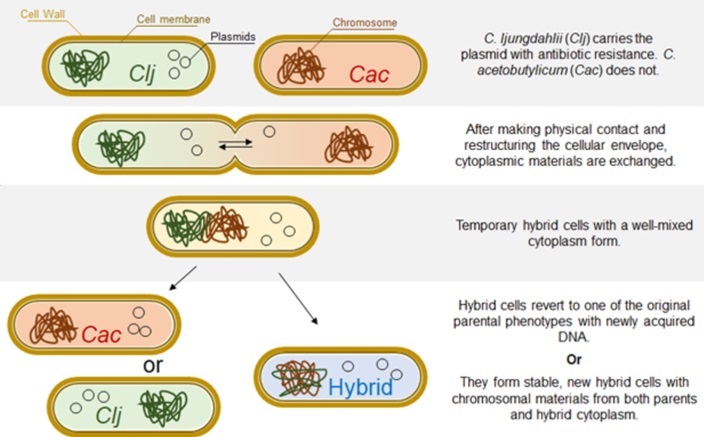 Heterologous cell fusion is said to be another way for bacteria to exchange genes, wholesale.
Heterologous cell fusion is said to be another way for bacteria to exchange genes, wholesale.
 "DNA transfer between two different species mediated by heterologous cell fusion in Clostridium coculture," by Kamil Charubin, John D. Hill and Eleftherios Terry Papoutsakis, mBio, 12 Jan 2024. "DNA transfer between two different species mediated by heterologous cell fusion in Clostridium coculture," by Kamil Charubin, John D. Hill and Eleftherios Terry Papoutsakis, mBio, 12 Jan 2024.
 "New insights into microbial evolution," by Erica K. Brockmeier, UDaily (+PhysOrg), 12 Jan 2024. "New insights into microbial evolution," by Erica K. Brockmeier, UDaily (+PhysOrg), 12 Jan 2024.
 New genes can be acquired only via HGT... This posting has become our hub for news about prokaryotic evolution. New genes can be acquired only via HGT... This posting has become our hub for news about prokaryotic evolution.
 Viruses... discusses transformation, conjugation and transduction, better-known means of bacterial gene transfer. Viruses... discusses transformation, conjugation and transduction, better-known means of bacterial gene transfer.
 I was calmly enjoying Andy Knoll's A Brief History of Earth (2021), not surprised by his dismissals of panspermia, when something seized my attention. Knoll had been a member of NASA's rover science team for the mission that sent two rovers to explore Mars. Soon after landing, in 2004, the Opportunity rover found evidence that Mars was once warm and wet. To announce the finding, March 2, "The briefing at NASA headquarters had only one rule: the scientists representing the team were to talk about water, but not life." Here's NASA's same-day news release:
I was calmly enjoying Andy Knoll's A Brief History of Earth (2021), not surprised by his dismissals of panspermia, when something seized my attention. Knoll had been a member of NASA's rover science team for the mission that sent two rovers to explore Mars. Soon after landing, in 2004, the Opportunity rover found evidence that Mars was once warm and wet. To announce the finding, March 2, "The briefing at NASA headquarters had only one rule: the scientists representing the team were to talk about water, but not life." Here's NASA's same-day news release:
 Opportunity Rover Finds Strong Evidence Meridiani Planum Was Wet, release 2004-074, JPL, NASA, 02 Mar 2004. Opportunity Rover Finds Strong Evidence Meridiani Planum Was Wet, release 2004-074, JPL, NASA, 02 Mar 2004.
The "one rule" is extremely troubling, because only a week earlier, February 27, Opportunity had photographed a fossil resembling a tiny sea animal. Without explanation, within three hours, NASA used the rock abrasion tool (RAT) to obliterate it. In December, NASA published the before-and-after photos of the fossil, not mentioning life:
 Evidence from Opportunity's Microscopic Imager for Water on Meridiani Planum [local PDF], by K. E. Herkenhoff, S. W. Squyres et al., doi:10.1126/science.1105286, Science, 03 Dec 2004. See Fig. 4. Evidence from Opportunity's Microscopic Imager for Water on Meridiani Planum [local PDF], by K. E. Herkenhoff, S. W. Squyres et al., doi:10.1126/science.1105286, Science, 03 Dec 2004. See Fig. 4.
 Did NASA's Opportunity rover find evidence for life on Mars in 2004? (Discussion and links.) Did NASA's Opportunity rover find evidence for life on Mars in 2004? (Discussion and links.)
Remember, in 1976, the Viking landers looked for life on Mars and got positive results. Then those results were disputed. More investigation would help, right? Inexplicably, no following Mars missions have carried life-detection equipment. Nevertheless, in 2004, Opportunity wandered into visible evidence for past metazoan life! So, NASA quickly destroyed the evidence and refused to discuss the subject? To be blunt, WTF?!
With that bit out of the way, this is a very readable book for a general audience, with plenty to teach advanced readers. The style is fun and relaxed, with helpful word pictures and amusing asides. Knoll is a respected and honored geologist who is also a friendly, expert tourguide.
 A Brief History of Earth: Four Billion Years in Eight Chapters by Andrew H. Knoll, Custom House, 27 Apr 2021. A Brief History of Earth: Four Billion Years in Eight Chapters by Andrew H. Knoll, Custom House, 27 Apr 2021.
 Life on Mars! has background and links about Viking. Life on Mars! has background and links about Viking.
 06 Feb: More about the fossil photographed by Opportunity. 06 Feb: More about the fossil photographed by Opportunity.
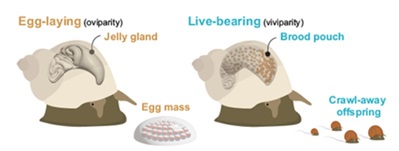 Periwinkles are oviparous (laying eggs for reproduction), except for two species that are viviparous (birthing live offspring). A European team has studied the genomes of these snails to learn how the transition was possible. They found that genes enabling live birth were recruited over millenia, and they were ultimately expressed when regulatory programming turned them on. In conclusion, the researchers elaborate,
Periwinkles are oviparous (laying eggs for reproduction), except for two species that are viviparous (birthing live offspring). A European team has studied the genomes of these snails to learn how the transition was possible. They found that genes enabling live birth were recruited over millenia, and they were ultimately expressed when regulatory programming turned them on. In conclusion, the researchers elaborate,
Our estimates of the timing of sweeps suggest that alleles associated with live-bearing were recruited gradually over the past 200,000 generations (~100,000 years). This finding is relevant to long-standing debate about the genetic basis of evolutionary novelty. Because key innovations are not visible to selection before they arise, models of saltational evolution invoke large-effect macromutations to explain their evolution. We do not know which mutation caused the threshold from egg-laying to live-bearing to be crossed. Some potentiating mutations may have preceded live-bearing but were critical to its origin, and others may have refined live-bearing after it arose. Nevertheless, our results suggest that new functions evolved gradually through the recruitment of alleles at many loci rather than arising in a single evolutionary step.
The main lesson that the researchers take from the study is that big steps in evolution can "evolve gradually," an issue even Charles Darwin worried about. Fossil evidence of punctuated equilibrium and the growing understanding of genomics have only highlighted the challenge. In this example, the genes have been slowly recruited, then turned on when the need is present. But this still leaves an issue mentioned in the conclusion, "key innovations are not visible to selection before they arise." This innovation, following longterm, multi-gene recruitment, would likewise remain invisible to selection until the programming is fully installed and then expressed. This would work only if the recruited genes already contain the programming for vivipary. If so, software management sytems in the genome could plausibly piece it together. Cosmic ancestry relies on the availability of life's programming, and its installation by robust software management. (BTW: Why did periwinkles "need" vivipary? The oviparous ones are still flourishing, apparently.)
 "The genetic basis of a recent transition to live-bearing in marine snails," by Sean Stankowski et al., Science, 05 Jan 2024; and commentary; "The genetic basis of a recent transition to live-bearing in marine snails," by Sean Stankowski et al., Science, 05 Jan 2024; and commentary;
 "Biologists uncover the secrets of evolutionary change," University of Sheffield (+Newswise), 04 Jan 2024. "Biologists uncover the secrets of evolutionary change," University of Sheffield (+Newswise), 04 Jan 2024.
 "The snail or the egg?" Institute of Science and Technology Austria via Newswise, 04 Jan 2024. "The snail or the egg?" Institute of Science and Technology Austria via Newswise, 04 Jan 2024.
 Robust Software Management has more about the role of a system that can assemble available programming. Robust Software Management has more about the role of a system that can assemble available programming.
![]()
|
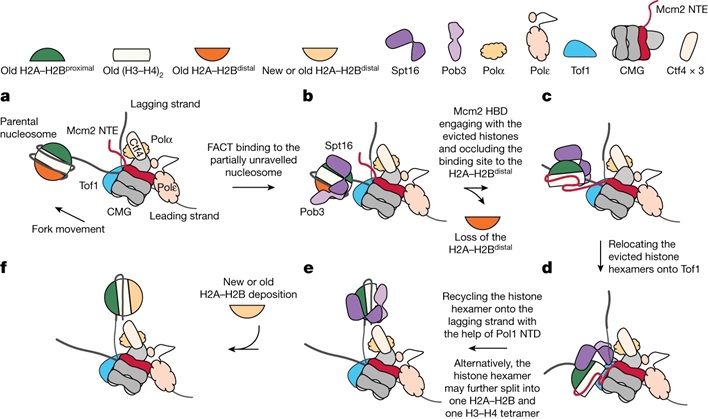
![]() "Parental histone transfer caught at the replication fork," by Ningning Li, Yuan Gao, Yujie Zhang, Daqi Yu et al., doi:10.1038/s41586-024-07152-2, Nature, 28 Mar 2024.
"Parental histone transfer caught at the replication fork," by Ningning Li, Yuan Gao, Yujie Zhang, Daqi Yu et al., doi:10.1038/s41586-024-07152-2, Nature, 28 Mar 2024.

 Fred Hoyle never expected biology to occupy his attention, but after Chandra Wickramasinghe showed him that interstellar dust looks like freeze-dried bacteria, he looked closely. While investigating the subject with Chandra, in 1983, he published The Intelligent Universe: A New View of Creation and Evolution. Now I am re-reading it.
Fred Hoyle never expected biology to occupy his attention, but after Chandra Wickramasinghe showed him that interstellar dust looks like freeze-dried bacteria, he looked closely. While investigating the subject with Chandra, in 1983, he published The Intelligent Universe: A New View of Creation and Evolution. Now I am re-reading it.
![]() Introduction... features H&W, mentions Arrhenius, and has history and links to others.
Introduction... features H&W, mentions Arrhenius, and has history and links to others.
![]() Panspermia Asks New Questions lists various kinds of panspermia.
Panspermia Asks New Questions lists various kinds of panspermia.
![]() Hoyle and Wickramasinghe's Analysis of Interstellar Dust makes the case for bacteria in interstellar space.
Hoyle and Wickramasinghe's Analysis of Interstellar Dust makes the case for bacteria in interstellar space.

![]() 28 Oct 2015: our notice including the Earthly crinoid fossils for comparison. Look for the listed features in them.
28 Oct 2015: our notice including the Earthly crinoid fossils for comparison. Look for the listed features in them.
![]() Thanks for alerting me to the fossil, Richard Hoover.
Thanks for alerting me to the fossil, Richard Hoover.

![]() Life on Mars! has history and updates.
Life on Mars! has history and updates.
![]() 09 Jan: This book review includes background.
09 Jan: This book review includes background.
![]()
![]() "Viroid-like colonists of human microbiomes," by Ivan N. Zheludev et al., BioRxiv, 21 Jan 2024.
"Viroid-like colonists of human microbiomes," by Ivan N. Zheludev et al., BioRxiv, 21 Jan 2024.
![]() Thanks for an alert, Kevin Keogh.
Thanks for an alert, Kevin Keogh.
![]() Viruses and Other Gene Transfer Mechanisms has more about better-known viral elements.
Viruses and Other Gene Transfer Mechanisms has more about better-known viral elements.
 Evidence for deterministic evolution now comes from a computer analysis of several thousand complete E. coli genomes by an interdisciplinary trio at The University of Nottingham. ...our results lead us to suggest that it is likely that rewinding the tape back to the start of E. coli evolution would still result in hundreds or thousands of predictable events taking place that are not contingent on those highly unlikely events unique to each replaying of the tape.
Evidence for deterministic evolution now comes from a computer analysis of several thousand complete E. coli genomes by an interdisciplinary trio at The University of Nottingham. ...our results lead us to suggest that it is likely that rewinding the tape back to the start of E. coli evolution would still result in hundreds or thousands of predictable events taking place that are not contingent on those highly unlikely events unique to each replaying of the tape.
![]() "Contingency, repeatability, and predictability in the evolution of a prokaryotic pangenome," by Alan J. S. Beavan, Maria Rosa Domingo-Sananes and James O. McInerney, PNAS, 26 Dec 2023 (includes illustration, right).
"Contingency, repeatability, and predictability in the evolution of a prokaryotic pangenome," by Alan J. S. Beavan, Maria Rosa Domingo-Sananes and James O. McInerney, PNAS, 26 Dec 2023 (includes illustration, right).
![]() Rewinding the Tape has background for this expression.
Rewinding the Tape has background for this expression.
![]() "The Forces That Drive Evolution May Not Be as Random as We Thought," by Tessa Koumoundouros, Science Alert, 20 Jan 2024.
"The Forces That Drive Evolution May Not Be as Random as We Thought," by Tessa Koumoundouros, Science Alert, 20 Jan 2024.
![]() Robust Software Management [under constrution] introduces this topic and makes a case for it.
Robust Software Management [under constrution] introduces this topic and makes a case for it.
 Heterologous cell fusion is said to be another way for bacteria to exchange genes, wholesale.
Heterologous cell fusion is said to be another way for bacteria to exchange genes, wholesale.
 I was calmly enjoying Andy Knoll's A Brief History of Earth (2021), not surprised by his dismissals of panspermia, when something seized my attention. Knoll had been a member of NASA's rover science team for the mission that sent two rovers to explore Mars. Soon after landing, in 2004, the Opportunity rover found evidence that Mars was once warm and wet. To announce the finding, March 2, "The briefing at NASA headquarters had only one rule: the scientists representing the team were to talk about water, but not life." Here's NASA's same-day news release:
I was calmly enjoying Andy Knoll's A Brief History of Earth (2021), not surprised by his dismissals of panspermia, when something seized my attention. Knoll had been a member of NASA's rover science team for the mission that sent two rovers to explore Mars. Soon after landing, in 2004, the Opportunity rover found evidence that Mars was once warm and wet. To announce the finding, March 2, "The briefing at NASA headquarters had only one rule: the scientists representing the team were to talk about water, but not life." Here's NASA's same-day news release:
![]() Evidence from Opportunity's Microscopic Imager for Water on Meridiani Planum [local PDF], by K. E. Herkenhoff, S. W. Squyres et al., doi:10.1126/science.1105286, Science, 03 Dec 2004. See Fig. 4.
Evidence from Opportunity's Microscopic Imager for Water on Meridiani Planum [local PDF], by K. E. Herkenhoff, S. W. Squyres et al., doi:10.1126/science.1105286, Science, 03 Dec 2004. See Fig. 4.
![]() Did NASA's Opportunity rover find evidence for life on Mars in 2004? (Discussion and links.)
Did NASA's Opportunity rover find evidence for life on Mars in 2004? (Discussion and links.)
 Periwinkles are oviparous (laying eggs for reproduction), except for two species that are viviparous (birthing live offspring). A European team has studied the genomes of these snails to learn how the transition was possible. They found that genes enabling live birth were recruited over millenia, and they were ultimately expressed when regulatory programming turned them on. In conclusion, the researchers elaborate,
Periwinkles are oviparous (laying eggs for reproduction), except for two species that are viviparous (birthing live offspring). A European team has studied the genomes of these snails to learn how the transition was possible. They found that genes enabling live birth were recruited over millenia, and they were ultimately expressed when regulatory programming turned them on. In conclusion, the researchers elaborate,